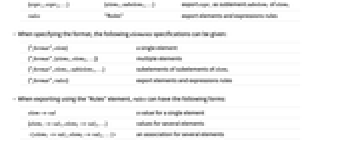- See Also
-
Related Guides
- Importing and Exporting
- Listing of All Formats
- Graphics Importing & Exporting
- WDF (Wolfram Data Framework)
- Raster Image Formats
- C/C++ Language Interface
- Creating Web Pages
- Audio Formats
- Importing & Exporting in Notebooks
- XML Import & Export
- Multimedia Formats
- Tabular Communication
- Audio Representation
- Files
- Video Creation
- Colors
- External Operations
- Wolfram Language File Formats
- Persistent Storage
- Video Processing
- Tabular Processing Overview
- Handling Live Mailboxes
- Local Objects
- Internet and Computer Systems Data
- Neural Network Construction & Properties
- Workflows
- Tech Notes
-
- See Also
-
Related Guides
- Importing and Exporting
- Listing of All Formats
- Graphics Importing & Exporting
- WDF (Wolfram Data Framework)
- Raster Image Formats
- C/C++ Language Interface
- Creating Web Pages
- Audio Formats
- Importing & Exporting in Notebooks
- XML Import & Export
- Multimedia Formats
- Tabular Communication
- Audio Representation
- Files
- Video Creation
- Colors
- External Operations
- Wolfram Language File Formats
- Persistent Storage
- Video Processing
- Tabular Processing Overview
- Handling Live Mailboxes
- Local Objects
- Internet and Computer Systems Data
- Neural Network Construction & Properties
- Workflows
- Tech Notes
Export["dest.ext",expr]
exports data to a file, converting it to the format corresponding to the file extension ext.
Export[dest,expr,"fmt"]
exports data in the specified format "fmt".
Export[dest,exprs,elements]
exports data by treating exprs as elements.
Export[dest,exprs,elements,options]
uses the specified options.


Export
Listing of Formats »Export["dest.ext",expr]
exports data to a file, converting it to the format corresponding to the file extension ext.
Export[dest,expr,"fmt"]
exports data in the specified format "fmt".
Export[dest,exprs,elements]
exports data by treating exprs as elements.
Export[dest,exprs,elements,options]
uses the specified options.
Details


- Export handles a large number of formats, each typically with many different possible elements. The possible formats are given in the list $ExportFormats, and in the "Listing of All Formats".
- By default, Export creates a file in the current directory given by Directory[].
- In Export[dest,…], dest can be any of the following:
-
"file" or File["file"] explicit file name "!prog" export data to a pipe CloudObject[…] a cloud object LocalObject[…] a local object - The following combinations of exprs and elements can be given:
-
expr elem export expr as elem {expr1,expr2,…} {{elem1,elem2,…}} export expri as elemi {expr1,expr2,…} {elem1,subelem1,…} export expri as sublement subelemi of elem1 rules "Rules" export elements and expressions rules - When specifying the format, the following elements specifications can be given:
-
{"format",elem} a single element {"format",{elem1,elem2,…}} multiple elements {"format",elem1,sublelem1,…} subelements of subelements of elem1 {"format",rules} export elements and expressions rules - When exporting using the "Rules" element, rules can have the following forms:
-
elem->val a value for a single element {elem1->val1,elem2->val2,…} values for several elements elem1->val1,elem2->val2,… an association for several elements elem1->{elem11->val11,…} values for subelements - Export takes an OverwriteTarget option for all formats. Possible settings include:
-
False do not overwrite an existing file True overwrite an existing file (default) "KeepBoth" keep the existing file, automatically choosing a name for the new file - Use Export[dest,…,options] to provide format-specific options that control the behavior of the export.
- Export[file,NotebookObject[…],…] when possible exports the content of the notebook referenced by the NotebookObject.
- New formats can be manually registered in the Wolfram Language. See the tutorial for "Developing an Export Converter".
Examples
open all close allBasic Examples (4)
Scope (13)
Basic Uses (5)
Export a SparseArray to a Matrix Market file:
Export a Dataset to a "JSONLines" file:
Export a Tabular object to a "Parquet" file:
Export "MP3" data to a "WAV" file:
Verify the format of the resulting file:
Export data using an option in "MP3" to exclude metadata:
Types of Formats (8)
Generalizations & Extensions (2)
Options (1)
OverwriteTarget (1)
Properties & Relations (1)
The first format returned by FileNameToFormatList is used by default in Export:
Related Guides
-
▪
- Importing and Exporting ▪
- Listing of All Formats ▪
- Graphics Importing & Exporting ▪
- WDF (Wolfram Data Framework) ▪
- Raster Image Formats ▪
- C/C++ Language Interface ▪
- Creating Web Pages ▪
- Audio Formats ▪
- Importing & Exporting in Notebooks ▪
- XML Import & Export ▪
- Multimedia Formats ▪
- Tabular Communication ▪
- Audio Representation ▪
- Files ▪
- Video Creation ▪
- Colors ▪
- External Operations ▪
- Wolfram Language File Formats ▪
- Persistent Storage ▪
- Video Processing ▪
- Tabular Processing Overview ▪
- Handling Live Mailboxes ▪
- Local Objects ▪
- Internet and Computer Systems Data ▪
- Neural Network Construction & Properties
Related Workflows
- Make Publication-Quality Graphics ▪
- Save a Notebook as a PDF ▪
- Generate JSON
History
Introduced in 1999 (4.0) | Updated in 2003 (5.0) ▪ 2004 (5.1) ▪ 2007 (6.0) ▪ 2014 (10.0) ▪ 2017 (11.2) ▪ 2019 (12.0)
Text
Wolfram Research (1999), Export, Wolfram Language function, https://reference.wolfram.com/language/ref/Export.html (updated 2019).
CMS
Wolfram Language. 1999. "Export." Wolfram Language & System Documentation Center. Wolfram Research. Last Modified 2019. https://reference.wolfram.com/language/ref/Export.html.
APA
Wolfram Language. (1999). Export. Wolfram Language & System Documentation Center. Retrieved from https://reference.wolfram.com/language/ref/Export.html
BibTeX
@misc{reference.wolfram_2025_export, author="Wolfram Research", title="{Export}", year="2019", howpublished="\url{https://reference.wolfram.com/language/ref/Export.html}", note=[Accessed: 02-January-2026]}
BibLaTeX
@online{reference.wolfram_2025_export, organization={Wolfram Research}, title={Export}, year={2019}, url={https://reference.wolfram.com/language/ref/Export.html}, note=[Accessed: 02-January-2026]}

